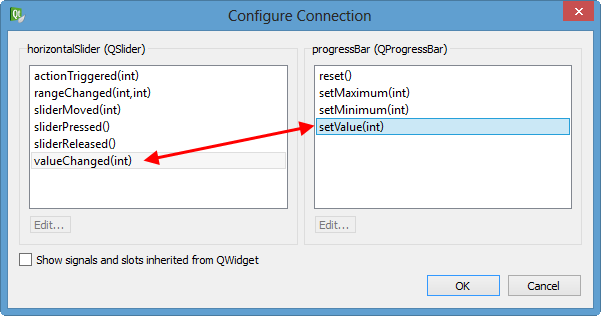Introduction
- Signal And Slot
- Qt Connect Two Signal
- Qt Connect Class Slots To Designer Signals
- Qt Connect Signal Slot By Name List
@poorrobert said in Connecting to slot by string name: of course you're right, but in this case I want to know how to connect with slot name in parenthesis so SLOT('testSlot')); is exactly what I want to try. Copied or Not Copied: Arguments in Signal-Slot Connections? Posted on 2013/06/29 by Burkhard Stubert How often is a an object copied, if it is emitted by a signal as a const reference and received by a slot as a const reference? Traditional syntax: SIGNAL and SLOT QtCore.SIGNAL and QtCore.SLOT macros allow Python to interface with Qt signal and slot delivery mechanisms. This is the old way of using signals and slots. The example below uses the well known clicked signal from a QPushButton. Qt automatically breaks a signal/slot connection if either the sender or the receiver are destroyed (or if context object is destroyed, when using the new connection syntax and connecting to free functions). This is a major feature of the signals and slots mechanism.
Remember old X-Windows call-back system? Generally it isn't type safe and flexible. There are many problems with them. Qt offers a new event handling system: signal-slot connections. Imagine an alarm clock. When alarm is ringing, a signal is being sent (emit). And you're handling it in a slot.
- Every QObject class may have as many signals and slots as you want
- You can emit signals only from within that class, where the signal is located
- You can connect signal with another signal (make chains of signals);
- Every signal and slot can have unlimited count of connections with other.
- ATTENTION! You can't set default value in slot attributes e.g. void mySlot(int i = 0);
Connection

You can connect signal with this template:
You have to wrap const char * signal and const char * method into SIGNAL() and SLOT() macros.
And you also can disconnect signal-slot:
Deeper
Widgets emit signals when events occur. For example, a button will emit a clicked signal when it is clicked. A developer can choose to connect to a signal by creating a function (a slot) and calling the connect() function to relate the signal to the slot. Qt's signals and slots mechanism does not require classes to have knowledge of each other, which makes it much easier to develop highly reusable classes. Since signals and slots are type-safe, type errors are reported as warnings and do not cause crashes to occur.
For example, if a Quit button's clicked() signal is connected to the application's quit() slot, a user's click on Quit makes the application terminate. In code, this is written as
Signal And Slot
Connections can be added or removed at any time during the execution of a Qt application, they can be set up so that they are executed when a signal is emitted or queued for later execution, and they can be made between objects in different threads.
Qt Connect Two Signal
The signals and slots mechanism is implemented in standard C++. The implementation uses the C++ preprocessor and moc, the Meta Object Compiler, included with Qt. Code generation is performed automatically by Qt's build system. Developers never have to edit or even look at the generated code.
Qt Connect Class Slots To Designer Signals
In addition to handling signals and slots, the Meta Object Compiler supports Qt's translation mechanism, its property system, and its extended runtime type information. It also makes runtime introspection of C++ programs possible in a way that works on all supported platforms.
To make moc compile the meta object classes don't forget to add the Q_OBJECT macro to your class.
